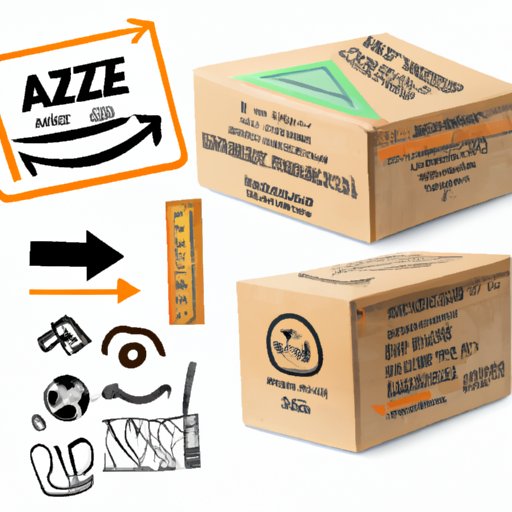
I. Introduction
When it comes to shopping online, there’s nothing quite as frustrating as waiting patiently for your package to arrive, only to find that it’s packaged in a way that’s difficult to open, wasteful, and ultimately harmful to the environment. That’s where Amazon’s Frustration-Free Packaging comes in.
Created to address customer concerns about excessive packaging waste and to make unboxing a more pleasant experience, Amazon’s Frustration-Free Packaging has revolutionized the way we think about online shopping. In this article, we’ll explore the ins and outs of Frustration-Free Packaging, why it’s important, and why it represents the future of sustainable shipping.
II. Decoding Amazon’s Frustration-Free Packaging: What Customers Need to Know
Frustration-Free Packaging is a term created by Amazon that refers to packaging that is easy to open, recyclable, and sustainable. Frustration-Free Packaging aims to make the unboxing experience as pleasant as possible, while also minimizing the impact of shipping on the environment.
One of the main differences between traditional packaging and Frustration-Free Packaging is the amount of excess materials. Traditional packaging often includes multiple layers of cardboard, plastic, and other materials that are difficult to remove and are ultimately thrown away. Frustration-Free Packaging, on the other hand, is made from recyclable materials and is designed to be as minimal as possible without compromising the safety of the product during transit.
Benefits of Frustration-Free Packaging for customers include ease of opening, reduced environmental impact, and the reassurance that the product is not damaged during transit. Frustration-Free Packaging also eliminates excess clutter and waste, which can be particularly beneficial for customers living in small spaces.
III. Why Amazon’s Frustration-Free Packaging is the Future of Sustainable Shipping
Shipping is a major contributor to greenhouse gas emissions, and the amount of packaging waste generated by the e-commerce industry is staggering. Frustration-Free Packaging is just one small way that companies like Amazon are trying to address these issues and create a more sustainable shipping process.
In addition to being made from recyclable materials, Frustration-Free Packaging is also designed to be more compact and efficient than traditional packaging. This means that more products can be shipped in a single container, which reduces the number of shipments required and the overall environmental impact of shipping.
Amazon’s commitment to sustainability goes beyond just their packaging innovations. They have also made significant investments in renewable energy, and have set a goal to power their operations with 100% renewable energy sources by 2025.
IV. How Amazon’s Frustration-Free Packaging is Revolutionizing the E-commerce Industry
The e-commerce industry has traditionally approached packaging as a necessary evil – a way to protect products during transit, but something that customers don’t really care about. Amazon’s approach, on the other hand, places a premium on the unboxing experience and customer satisfaction.
One of the ways that Amazon has revolutionized packaging is through their use of proprietary algorithms that determine the optimal packaging for each product. By analyzing the size and weight of the product and comparing it to their database of packaging options, Amazon is able to create custom packaging solutions that are both sustainable and effective.
Amazon is also leading the way in terms of package-less deliveries. With initiatives like Amazon Locker and Amazon Key, customers can receive their packages without any packaging at all. This not only reduces waste but also eliminates the need for delivery trucks to make multiple stops in the same area, which reduces emissions and traffic congestion.
V. The Benefits of Amazon’s Frustration-Free Packaging: A Comprehensive Guide
There are many benefits to Amazon’s Frustration-Free Packaging, both for customers and for the environment. For customers, Frustration-Free Packaging makes the unboxing experience easier, reduces clutter and waste, and eliminates the frustration associated with traditional packaging. Some specific examples of products that benefit from Frustration-Free Packaging include computers, printers, and other electronics, as well as toys and other items with many parts.
From an environmental perspective, Frustration-Free Packaging reduces the amount of waste generated by the shipping process, minimizes the use of fossil fuels and other non-renewable resources, and optimizes the use of space in shipping containers. In addition to Frustration-Free Packaging, Amazon has also implemented other sustainable packaging solutions, including their “Ship in Own Container” program, which allows customers to ship items in their original packaging.
VI. Unboxing Amazon’s Frustration-Free Packaging: Is It Worth It?
Some customers have expressed concerns about the cost and feasibility of using Frustration-Free Packaging. However, studies have shown that Frustration-Free Packaging can actually be more cost-effective than traditional packaging, particularly for manufacturers who are able to save on materials and shipping costs.
Additionally, many of the concerns that customers have about Frustration-Free Packaging – such as the safety of the product during transit – are unfounded. Amazon’s proprietary algorithms ensure that each product is packaged in a way that is both sustainable and safe for transport.
Overall, the benefits of Frustration-Free Packaging far outweigh any potential drawbacks. By reducing waste, optimizing shipping logistics, and increasing customer satisfaction, Frustration-Free Packaging represents the future of sustainable shipping.
VII. Conclusion
Amazon’s Frustration-Free Packaging represents a major step forward in the way we think about packaging and shipping. By focusing on sustainability and customer experience, Amazon has revolutionized the e-commerce industry and is helping to create a more sustainable future.
We encourage readers to try Frustration-Free Packaging for themselves and see the benefits firsthand. Together, we can all work towards a more sustainable and efficient shipping process.




